The Lenovo ThinkPad A285 (12.5-Inch) Review: Ryzen Pro Gets Down to Business
by Brett Howse on December 18, 2018 8:00 AM EST- Posted in
- Laptops
- AMD
- Lenovo
- ThinkPad
- Vega
- Ryzen
- Ryzen PRO
- Ryzen Mobile
- Vega Mobile
System Performance
The Lenovo ThinkPad A285 comes with the AMD Ryzen 5 Pro 2500U processor, which offers four cores, eight threads, and a base/boost frequency of 2.0 GHz / 3.6 GHz. It’s 200 MHz less than the 2700U model on both the base and boost frequency. AMD only supports DDR4 RAM – neither LPDDR3 or LPDDR4 are supported – and as such Lenovo offers 8 GB of DDR4 in a dual-channel configuration, but with no upgrade options available on the US website. It would be nice to see a 16 GB offering, but for office tasks, 8 GB should suffice. The storage offerings are 256 or 512 GB SSDs.
The big difference between the Ryzen 5 and Ryzen 7 APUs is in the GPU, where Ryzen 7 gets Vega 10, and Ryzen 5 loses two GPU cores and some clockspeed headroom, giving us Vega 8.
To compare performance, the ThinkPad A285 was run through our standard testing suite, and comparisons are of other similar devices. Of note, the Acer Swift 3 that we tested has the Ryzen 7 2700U, and just in case you’re wondering how the A285 stacks up against an older dual-core laptop, we’ve also included the ThinkPad X1 Yoga from a couple of years ago, with the Core i7-6500U. If you’d like to compare the Thinkpad A285 to any other device we’ve tested, please check out our online bench.
PCMark
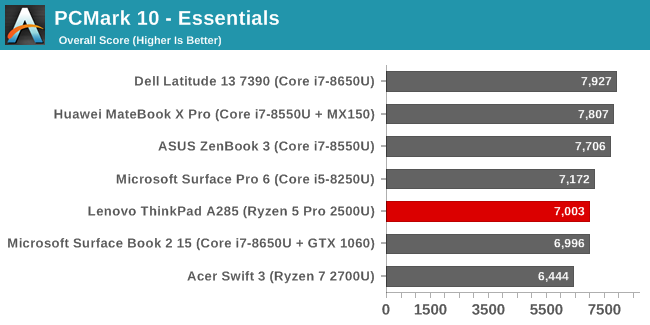



UL Benchmark’s PCMark 10 is the latest version of their industry standard set of tests, updated for Windows 10 with new workloads. It tests a wide range of tasks from productivity to digital media creation.
The ThinkPad A285 is middle of the pack, especially in the productivity results. The Ryzen 5 Pro holds its own here, and if compared to the only Core i5 device in the list, the Surface Pro 6, it is generally neck and neck with it.
Cinebench

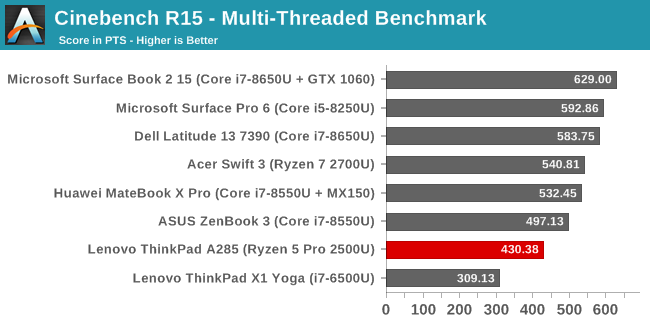
Cinebench is a purely CPU test, and it can be run as both a single-threaded or multi-threaded workload, which makes it a nice way to take a quick look at the single-threaded performance of a modern CPU, and how well that performance scales to multiple cores and threads. AMD’s single-threaded performance is not quite up to par with the fastest Core i7 models, and the Ryzen 5 Pro in the ThinkPad A285 is near the bottom in both results. With just a 200 Mhz deficit to the Ryzen 7 2700U in the Acer Swift 3, it is just barely behind it in the single-threaded test, but on the mult-threaded variant it falls farther behind.
x264
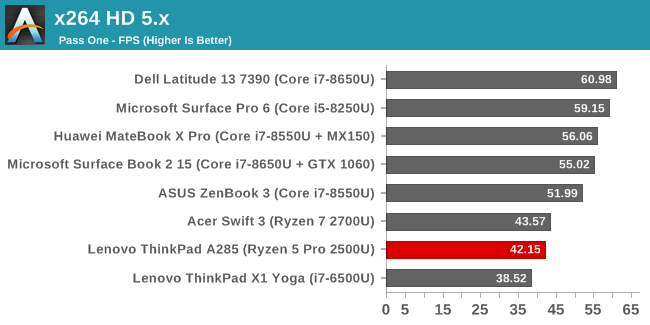

Another CPU test is x264, which converts a 1080p video using the x264 codec, and like Cinebench it loves lots of cores and high frequencies. The Thinkpad A285 is at the bottom of this result compared to other modern devices, but with the extra threads and cores, it is well above the Skylake powered ThinkPad X1 Yoga.
Web Tests
Web tests are important because clearly the web is a fundamental part of computing now, but it’s also difficult to compare devices due to the sizeable impact the browser’s scripting and rendering engines can have. Browsers continue to get updated as well, so our results are a snapshot in time.
For all of our testing, we leverage Microsoft Edge to keep that part of the equation normalized as much as possible, although Edge is updated with every feature update of Windows as well.
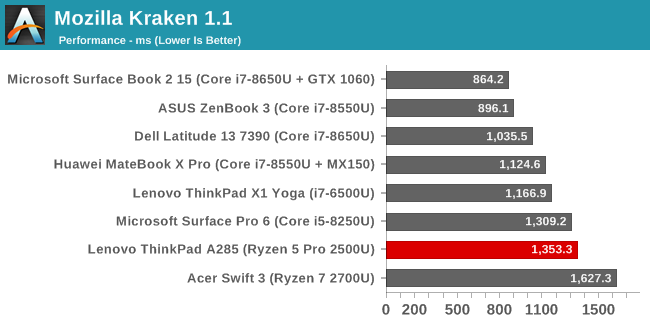
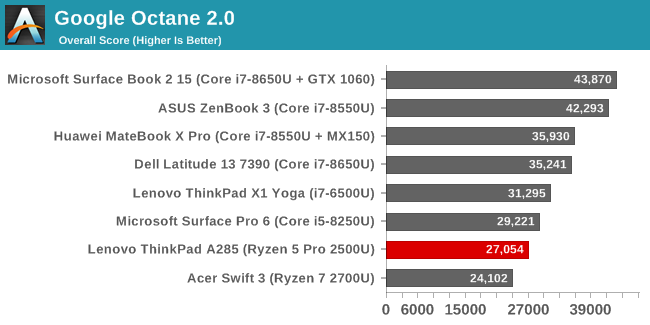
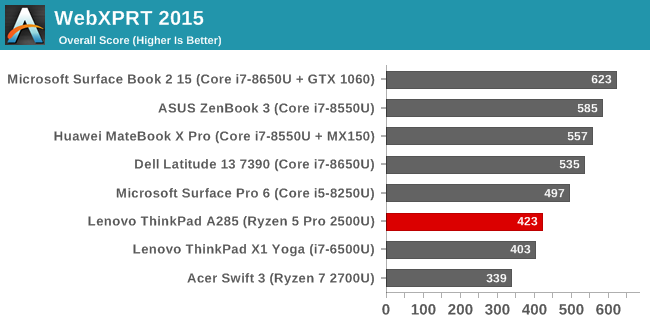
With just a 3.6 Ghz boost frequency, the Ryzen 5 Pro can’t quite match the Intel devices on any of our web tests, and Intel has worked hard to improve its frequency ramp-up speed as well which pays dividends here where workloads tend to be short. It’s very interesting to see just how far the performance has come since we tested the Ryzen 7 2700U in the Acer Swift 3 though, with the slower Ryzen 5 Pro in the ThinkPad A285 trouncing it.
Storage Performance
Lenovo offers both a 256 and 512 GB SSD in the A285, and the review unit ships with the larger one, which will have better performance than the smaller version.
The SSD in the laptop is Lenovo-branded LENSE30512GMSP34MEAT3TA, which appears to have been produced by fellow Chinese firm Ramaxel. Since SSDs tend to be mult-sourced these days, there’s no guarantee this will be in every unit shipped.
This is an NVMe drive though, and as such offers great read speeds capping out the x4 PCIe interface. Write speeds are much lower thanks to the NAND which is almost certainly TLC.
Overall, despite this SSD not being a well-known model, the performance is still more than adequate for office tasks.


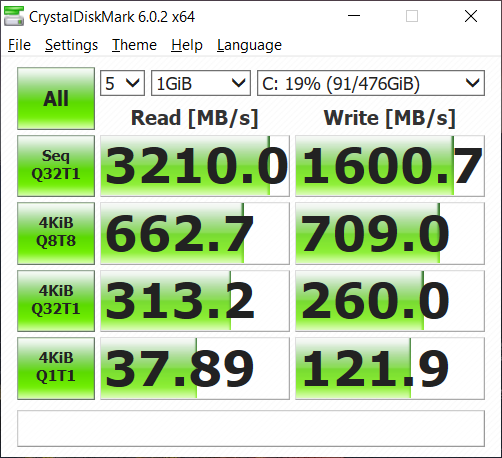








72 Comments
View All Comments
Brett Howse - Tuesday, December 18, 2018 - link
The Surface Book 2 was the device I had power draw numbers from for the idle power draw graph so I have no issues including it in the performance graphs as well. The CPU is a 15W i7. The GPU is of course more powerful but that's still a valid point since people may wonder how close Vega in an iGPU factor is coming to dGPUs.But the best part is that if you don't think it's important, you can just ignore that data point and compare against all the others. Or, click the links I provide to our Online Bench database and make any comparisons you prefer. We provide all the data.
QChronoD - Wednesday, December 19, 2018 - link
I think that many of the people who were complaining about that would accept the comparison if an estimated price of each machine was given at the beginning. If you knew before looking at the graphs that one of the laptops was 2x the price and it looks like being 2x as fast then everything is fine, but if you aren't aware of the price difference then it looks like this machine is a steaming pile.QChronoD - Wednesday, December 19, 2018 - link
Just for reference if anyone actually reads the comments:Microsoft Surface Book 2 15 - $2600
Dell Latitude 13" 2-in-1 7390 - $1800
Asus Zenbook 3 - $1500
Huawei Matebook X Pro - $1350
Lenovo ThinkPad X1 Yoga - $1500
Lenovo ThinkPad A285 - $1200
Microsoft Surface Pro 6 - $1000
Acer Swift 3 R7-2700U - $700
These are just quick prices off amazon trying to get similar specs.
IGTrading - Thursday, December 20, 2018 - link
I agree AnandTech provides "all the data" and that's of course laudable.But often times you can bury a good product in all that data. Comparing a 1200 USD notebook with 2600 USD notebooks is way beyond a stretch.
The potential buyer reading the review for a 1200 USD model is reading it for a reason: because that's what he wants (a 12" portable) or that's his budget (1200 USD) .
Ok ... you compare it with other similar sized notebooks that are also similarly priced ... such as 900 ~ 1400 USD ...
But I honestly have the feeling the results of the Lenovo AMD Ryzen-based notebook are buried in "all the data" ...
Like I've said ... this doesn't look like a review at all and also it doesn't look like a Round-Up (several notebook in a certain price range or with similar characteristics) ..
Going from 700 USD to 2600 USD as a price range ... And from 12" to 15" as a size range ... makes this look like somebody wanted to make the AMD Ryzen portable look slower than a notebook which is much larger and more than 200% more expensive ....
This is how a just comparison should look like in my view (Test Product vs. Similar Products in the Same Product Range vs. 1 product from the Upper Product Range as a comparison example) : https://hothardware.com/ContentImages/Article/2690...
And Ryzen did not beat the CPU+dGPU either ... nor did it ace all the tests ... but I never had the feeling of its results being buried in "all the data" ... just IMHO
kaidenshi - Tuesday, December 18, 2018 - link
Yep, two thin netbooks/ultrabooks I've had in the past had pop-down Ethernet ports, which were the same height as a USB-A port when not in use.thesavvymage - Tuesday, December 18, 2018 - link
honestly though, why do you need an ethernet port on the device? Its kinda just wasting space since its not like you plug that in separately, it should just be connected to whatever dock you have at someone's desk. If I had to plug in power, monitor, and ethernet separately every time I sat at my desk I'd go mad.Right now at work I'm using a macbook and its pretty simple to have all that plugged into a USB-C dock
SaolDan - Wednesday, December 19, 2018 - link
In my line of work i have to be able to connect to lightin controllers and switches thru ethernet out in the field so a Ethernet por would be required.The_Assimilator - Wednesday, December 19, 2018 - link
Not to mention that you have to fork out extra for the dongle!darkich - Tuesday, December 18, 2018 - link
.. a 768p TN entry level screen?Really? My goodness
PeachNCream - Tuesday, December 18, 2018 - link
12.5 inches. At 1080p on that size screen, scaling will be a thing and some software still sucks at scaling. Scaling will also mean that basically the same quantity of information can be displayed at the same time even if the resolution is higher. The GPU will work harder and consume more power while generating more heat to push pixels that do not benefit productivity.